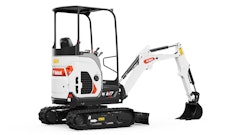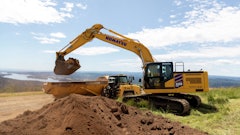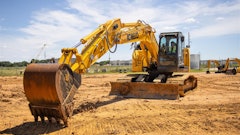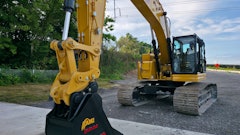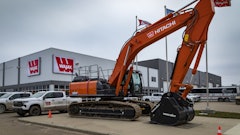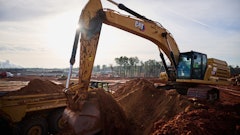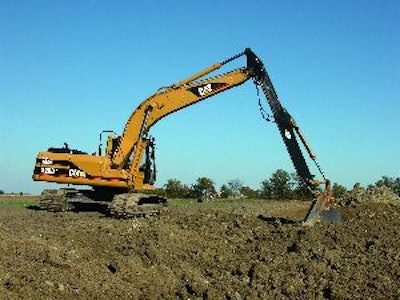
Almost every excavator manufacturer offers long boom and stick configurations, ranging from a few feet of added reach to in excess of 60 ft. "Super Long Front excavators stretch the digging reach of regular excavators by as much as double," notes Matthew Hendry, product consultant - hydraulic excavators and ADTs, Deere & Company.
Aftermarket attachments are also available in a range of lengths. For example, Paul Wever Construction Equipment engineers sticks and booms from 8 up to 100 ft. of additional reach. "I am a custom builder, so people come to me with their specific needs and we build the extensions that meet the specific job," says Paul Wever.
Such attachments provide more flexibility than OEM long-reach setups, which tend to be dedicated machines. "Obviously, you cannot start lifting manhole covers with a machine that has 60 ft. of reach. So it is hard for some end users to justify having that single tool if they don?t have work for it all of the time," says Wever. "With our attachment, they can add it to the excavator, do their job, then take it off and go back to normal trench digging." The switch takes about three to four hours with a typical 40,000- to 70,000-lb. excavator.
Whether you choose a dedicated machine or aftermarket attachment, there are trade-offs associated with the additional reach. "Lift capacity will be reduced and dynamic instability increased, resulting in the perception of tippiness," says Lew Miller, director of engineering, LBX Co., supplier of Link-Belt excavators.
In addition, long sticks and booms are more easily damaged if not used properly. "Longer booms and sticks are more susceptible to twisting forces than standard-length attachments," says Bret Jacobson, product manager, earthmoving excavators, Liebherr Construction Equipment Co. "Side loads induced through the bucket into the stick and boom will fatigue these structures over time... In some cases, for very long attachments, the stick cylinders and bucket cylinders are downsized to keep forces on the attachment within a range that the boom and stick can safely withstand."
More length equals less force
Digging forces on dedicated long front (LF) machines have been adjusted by the OEMs to optimize their capabilities without sacrificing equipment longevity. "Digging forces are lowered on LF machines in order to ensure that the front structures provide acceptable life for the customer," Hendry explains. "This is accomplished by lowering the hydraulic relief pressures."
These settings should not be adjusted in the field, since this is likely to result in structural problems. "Our engineers have done the math and know what the machines can safely handle with a LF boom/arm," says Hendry. "Contractors should not change the machine?s settings or they risk very expensive repairs or replacement of the boom/arm."
With aftermarket attachments, there is a risk if the hydraulic relief settings on the host machine are not matched to the increased leverage of a longer stick and boom.
"Failing to lower the digging forces will cause rapid damage to pins and bushings at the boom/arm connection and possibly cause other structural damage," Hendry explains. "There are tremendous leverage forces being applied when you add several feet of length to a standard excavator boom/arm. So extreme caution must be used or the low-cost option of the [boom/arm extension] could become a very expensive option because of damage to the host machine."
Care must also be taken to calculate available crowd force. "Since the crowd force is proportional to the length of the stick, a contractor can estimate a percentage decrease in crowd force compared to how much longer the stick is from standard," says Jacobson. "If there is any doubt, the contractor should request a calculation from the attachment manufacturer to be sure that the long attachment will suit the application at hand."
Know your lift capacity limitations
Miller emphasizes the need to read and understand lift capacity charts for long boom and stick configurations. They provide the maximum acceptable lift at a given reach.
If a lift capacity chart is not available, there is a simple formula to approximate lift capacity at various boom and stick lengths. "A good rule of thumb is 2% loss for every 1 ft. of extra reach based on the original manufacturer?s brochure," says Wever. "This is a calculation of distance and moment arm. That is a safe number."
But estimating lift capacities can be a risky proposition. "Contractors should never estimate the lifting forces for any attachment," Jacobson asserts. "In every case, a lifting chart valid for the attachment on the machine should be placed in the operator?s cab and in documentation of the machine. This is the best way to prevent accidents on the jobsite due to overloading."
As a general rule, the longer the attachment, the smaller the bucket that can be used. "However, this is largely dependent upon the specific weight of the material," Jacobson notes. "The operator must always stay at or below the lifting capacity of the machine with a full bucket."
Resist the temptation to push lift capacity limits in the hopes of increased productivity. "Over bucketing a LF machine will cause machine stability problems and significantly slow machine cycle times, eliminating any perceived increases in production," says Hendry.
When calculating lift capacity, you must first know the exact length of your excavator front, says Hendry. "Second, you must know the exact weights of the material you intend to pick up," he states. "Third, you must know the exact maximum load your LF machine can lift at maximum reach ? over the front and, more critical, over the side.
"These numbers dictate what you can safely lift without exceeding the stability limits of the machine," he adds. "Then you can properly size the attachment." For example, if the machine can lift 10,000 lbs. and the grapple you?re using weighs 5,000 lbs., you will be limited to 5,000 lbs. of material per cycle.
"In general, the combined weight of the tool and any material to be handled should never exceed the published lifting capacity of the machine," Jacobson emphasizes. "If there is any doubt in the contractor?s mind about the suitability of an attachment for a particular boom and stick combination, the manufacturer should be contacted for a suitability study."
No replacement for experience
When it comes to LF excavators, only skilled operators need apply. "Super LF excavators are unique machines that require a skilled operator who is properly trained in long-front operation," says Hendry. "Any side sweeping motion of the boom/arm can and does cause twisting damage. LF excavators are designed to be used in an ?in and out? motion or, more directly, a ?pulling? motion. The boom/arm is not designed for heavy digging like a standard boom/arm machine. Super LFs have to be operated with great care and finesse."
This calls for an experienced operator who can maintain precise, deliberate movements. "Depth perception with the long fronts will be very different than a standard machine; operator concentration is imperative," says Hendry. "Banging the bucket on the ground while swinging will cause severe damage to the boom/arm. The long boom/arm configuration changes the center of gravity of the machine, so an operator will need to understand the difference between a regular machine and the LF machine."
The operator must also understand the difference in the range of motion. "In some cases, the attachment or the working tool on an excavator equipped with a long boom or stick could come into contact with the operator?s cab, some other part of the uppercarriage or the undercarriage of the machine," says Jacobson. Optional stick limiter kits are available from most manufacturers to prevent contact with the machine.
Next, be aware of the excavator?s increased circle of operation. "The most important thing that I have found over the years is people tend to get complacent with their surroundings," says Wever. "When you have a longer stick and a boom, the circle you are working in has increased dramatically. So now the guy who always used to be safe because he was 40 or 50 ft. away ? that is no longer a true statement. Your work area is larger and work is farther away, so you have to pay attention to swing speed and blind spots in the machine. It is those types of things that you don?t get to ignore when you have a long reach boom."
The swing speed of the attachment increases proportionally with the length of the boom and stick. "Since the attachment is longer, the speed the attachment is traveling will be greater than with a shorter attachment," says Jacobson.
"When you swing your tractor, your bucket is at a certain speed at a certain distance from the centerline of the tractor," Wever points out. As the distance from the centerline increases, so does the speed at which the attachment is moving.
For example, a bucket that travels 25 mph on a standard machine may travel 60 mph on an excavator equipped with a 30-ft. extension. "Your reaction times all change," Wever notes. Consequently, the operator needs to be conscious of this difference and slow down a little.
This is where proportional controls can be a big advantage. "Most excavators are equipped with multiple working modes," Jacobson comments. "The operator of a machine with a very long attachment should choose a mode that will decrease the hydraulic flow, so that the attachment can be easily controlled and the excavator will work smoothly."
Attachment Yields Versatile Solution
Odessa, FL-based PAW Materials is a diversified demolition contractor and materials supplier that shares synergies with a sister trucking company. The contractor thrives on unique jobs.
"We want to be creative and skilled at what we do," says Rick Wohlfiel, owner. "We work on projects other people pass over. We want to work on those really tough ones." The company tackles residential, commercial and industrial projects. "You have to be diverse," says Wohlfiel.
This diversity carries over to the equipment fleet, which includes three crushers and over 20 pieces of heavy iron. "Diversity in any tool that I buy is of huge importance," says Wohlfiel.
"When I am purchasing a piece of equipment, I want to make sure it has the ability to do multiple tasks." When Paw Materials ran across a job calling for concrete to be broken over 50 ft. in the air, a solution was needed that could complement the existing fleet. After doing some Internet research, Wohlfiel found it in the Extend-A-Boom from Paul Wever
Construction Equipment (PWCE). The Extend-A-Boom transformed a Caterpillar 325 into a long-reach machine that could operate at 51 ft. with a hydraulic hammer. Paul Wever advised Wohlfiel on the correct stick size for the job, as well as the proper size hammer to mount on the end of the stick.
Wohlfiel has been pleased with the results. "I was very impressed at how well I was able to apply pressure with this hammer," he states. The machine performed without a hiccup throughout the project. "I never had anything go wrong with it. Everything worked fantastic for me."
Wohlfiel credits this success to carefully following instructions. PWCE worked out the math and advised him on what could be done with the excavator and stick, including proper sizing of the attachments and buckets.
Next, only experienced operators were allowed to run the machine, initially under supervision.
"I use only my most skilled people. You want your most cautious people on it," Wohlfiel emphasizes. In the wrong hands, this setup can be dangerous. "When you are dealing with the Extend-A-Boom, you can actually reach up and hit your own cab. You want to make sure you use your most skilled people and go through the risks involved. Make sure they understand them before you just hand them the keys. I ran it myself and I worked with the operators on the jobsite. I managed them and made sure there was a clear understanding what it will and will not do before I let them loose."
Now that the project has been completed, the Extend-A-Boom is still proving to be an important piece of the PAW Materials equipment arsenal. In addition to working as a demolition tool, it is being used to clean ponds. And when it?s not needed, the Caterpillar 325 can be quickly transformed back into a standard excavator.


![Hcm Ax Landcros Dual Branded Logo[25]](https://img.forconstructionpros.com/mindful/acbm/workspaces/default/uploads/2025/11/hcmaxlandcros-dual-branded-logo25.Qhg3vUCjoK.jpg?auto=format%2Ccompress&bg=fff&fill-color=fff&fit=fill&h=100&q=70&w=100)
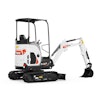
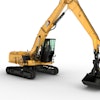
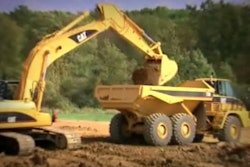





![Hcm Ax Landcros Dual Branded Logo[25]](https://img.forconstructionpros.com/mindful/acbm/workspaces/default/uploads/2025/11/hcmaxlandcros-dual-branded-logo25.Qhg3vUCjoK.jpg?ar=16%3A9&auto=format%2Ccompress&bg=fff&fill-color=fff&fit=fill&h=135&q=70&w=240)
